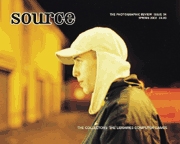EDITORIAL:
Issue 34 — Spring 2003
Issue 34 — Spring 2003
View Contents ▸
Collectors and Curfews
The production of the computer game The Getaway involved the recreation of central London using photography as its principal tool. Sam Coates the lead artist on the project explains how this was achieved. The way the images were cleaned and manipulated to be perceived in the game environment shows how the 'reality' of photographs can be used to contribute to the construction of a virtual world.
The reality of life in Britain is examined by Tobias Zielony and Clayton Irwin. In 2000 9pm curfews were introduced by the Blair government. The legislation covers those up to 16 years old. Tobias Zielony has photographed groups of teenagers in Bristol, Newport and Cwmbran as their curfew hour approaches and then passes. He follows them as they move towards the edges of these towns and away from the constraints of social control. Clayton Irwin's images are part of an ongoing project in which he tries to make sense of the political undercurrents in contemporary Britain. He has photographed racist attacks, suburbia and the celebration of the Queen Mother's 100th birthday.
Private collectors have an influence on the way we understand photography by simply bringing their collections together and more subtly by the uses and interpretations they give them. Sean Sexton has been collecting Irish photographs since 1973 and has strong views about what they can tell us about Irish history. Michael Wilson has a wealth of 19th century photographs which he would like us to consider in aesthetic terms. He also believes that the collector has a positive contribution to make to the national photographic institutions and that this has not been properly recognised in Britain.
An extreme impulse to collect is revealed by Andrew Robinson in his photographs of the home of a person with Obsessive Compulsive Disorder. He was asked to record it by the owner before it was forcibly cleared by the local council. On a smaller scale Stephen McCoy photographs the contents of his Dyson vacuum cleaner. These show strata that contain a dust archaeology of recent events in his house.
Libraries have an important and overlooked role in defining the way we understand photography, both in selecting what is purchased on behalf of the public but then also in deciding how it is categorised. Pete James discusses some of the dilemmas that face librarians when trying to fit this protean subject in their indexes.
This spring Source will be visiting more venues and meeting more photographers than ever, to bring you the best previously unpublished work. Finally, find enclosed the latest in Joachim Schmid's Masterpieces of Photography gaming card series, this issue it's the Americans.
— The Editors





